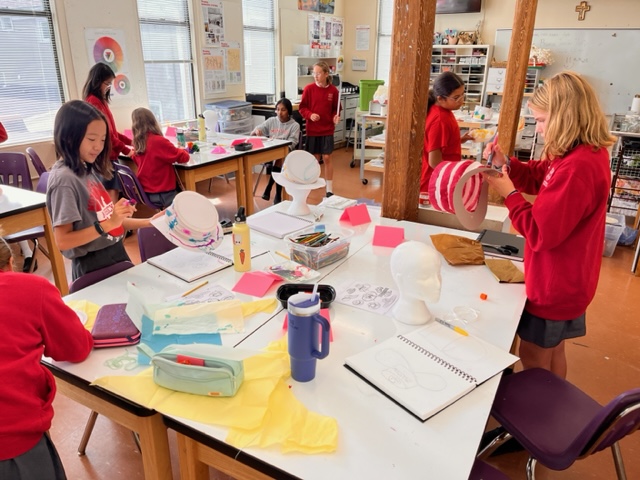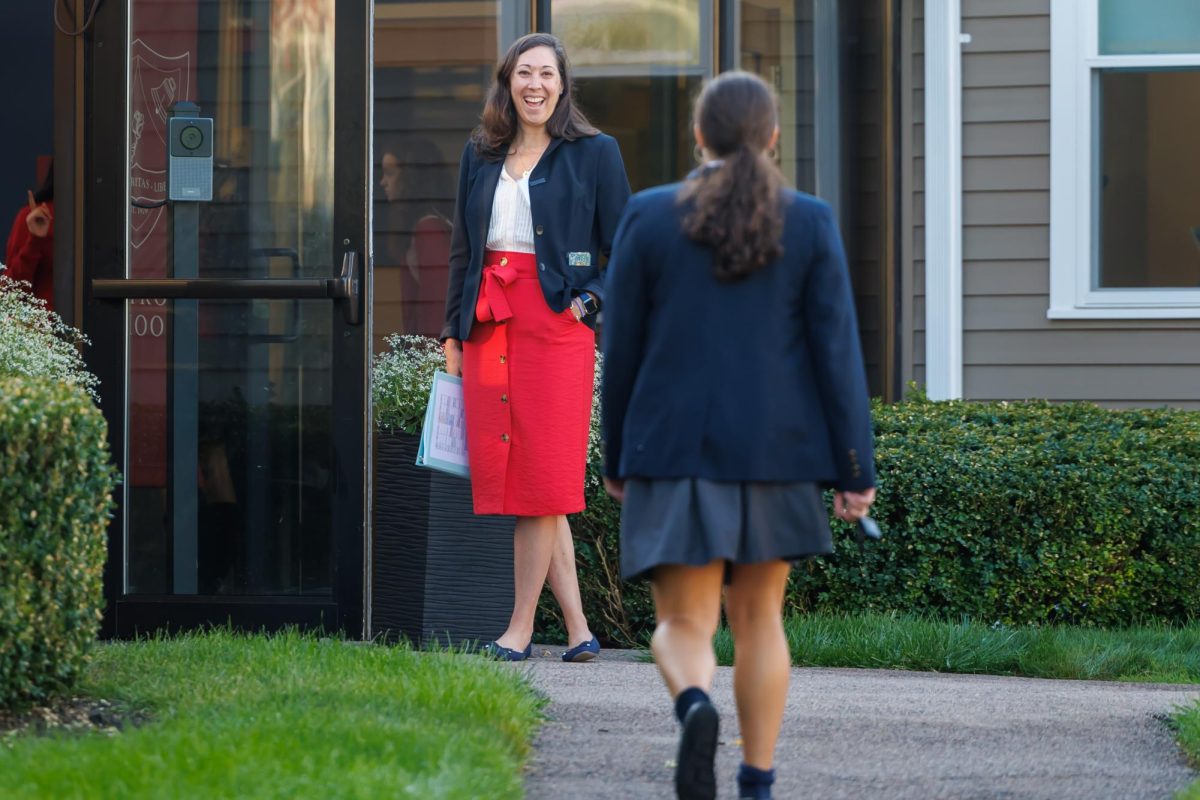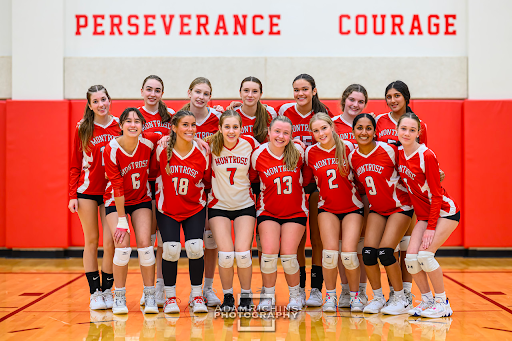On Wednesday, September 27th, Mr. Richard DeSorgher came to the Montrose M&M to educate students, faculty, and parents on the history of our Medfield campus, which was once a flourishing straw hat factory – the second largest in the country. Mr. DeSorgher was born and raised in Medfield, is a member of its historical society, and has served in many government commissions for the state of Massachusetts. He has written many books and articles, including a weekly newspaper column, and hosts talks and tours on Medfield history. He has a very lively personality and spoke with passion in every word he said, clearly engaged and in love with the topic.
Mr. DeSorgher began his lecture with a few jokes, including “Where do sheep get their hair cut? At the baa-ber shop!” and began to speak of the building, now Montrose, that was once a booming New England industry. For many centuries, straw hats have been a staple of rural daily wear, but they became fashionable in the upper classes of both England and France in the mid-eighteenth century. The trend soon spread to the United States. Many Italian brands manufactured these hats, but they could only be afforded by the affluent, so many small storefronts in New England started to make straw hats to sell at affordable prices. Local oats and rye were used to craft these hats, and women of the area would be hired to create them. The women did their work at home, with the materials dropped off and collected by horse and buggy, along with their pay. Soon, many of these shops devoted themselves solely to straw hat making, and the industry went to the factories.
In Medfield, the straw hat factory employed girls at the ages of 11 to 80. Women from rural Maine and Canada came to find work and better futures here. While they worked, the women sang songs, read novels and spiritual works, and told stories along with many employee parties, boosting the morale of the community. Soon, the factory gave work to over 1,200 people, bigger than the Medfield population at the time. At this time, the factory was run by Walter Janes, who Janes Avenue is named after, and Daniel D. Curtis. The company was named after these two. After Mr. Janes’ passing, the factory was taken over by Mr. Curtis, and renamed D. D. Curtis Company. At that time, the company was manufacturing 3,000 hats, many being sold by representatives in New York City. In 1871, the original factory was burned down in a fire, and a new one was constructed in its place, pieces of which are now part of our school building.
Here is where, as Mr. DeSorgher sees it, “the most important person in Medfield history,” enters the picture. Colonel Edwin Vinald Mitchell, a “penniless” man from neighboring Framingham, started work at the Medfield Straw Hat factory as a manager, and after Mr. Curtis’ death, became the owner of the company. He received the title ‘Colonel’ from working in state commissions for Massachusetts and was a very respected man. October 2nd, Col. Mitchell’s birthday, was both a company and a public holiday in Medfield, where employees of the straw hat factory were able to attend fairs for free and enjoy the day off with family and friends. This is also Montrose’s Founders’ Day, celebrating its opening day 44 years ago. This, to my great surprise, was only coincidentally aligned with Col. Mitchell’s birthday and was as new a fact to many faculty members as it was to me!
By the end of the 19th century, the straw hat factory was a booming business, making 5,000 hats. The straw was now imported from China, and every room of the factory was used for a different purpose. What is now the Montrose parking lot was a boarding house for the young girls who came from afar to seek employment at the hat factory, with Col. Mitchell’s mansion right across the street, where the post office is now. In the summer months, the women made felt hats for the winter season, and from December to May, straw hats were made for the warmer weather. Girls would come to work in Medfield from farming communities for winter work and return home to help with farming in the summer. The summer staff was made up of many teachers who wanted to work while school was out. By 1899, Col. Mitchell was in complete control of the factory, and its name was changed to the Edwin V. Mitchell Company, and the industry was kept in the family even after the Colonel’s passing.
The straw hat factory was prosperous up until the Great Depression when it hit hard times. The company even had to close in 1933 but opened soon again in 1934. After this, the factory never quite recovered its former glory. By the 1950s, there was a strong will to unionize among the workers, which the owner responded to by threatening the closure of the company if it were to happen. The union was created despite the warning, and, as promised, the factory was closed. After that, the building went through many hands and even vacancies before Montrose renovated it into what is our beloved campus today.
Concluding his address, Mr. DeSorgher connected the lives of the girls working at the straw hat factory over a century ago to the lives of Montrose students today: we all took a risk to come here, like the factory workers did, in search of a better future and found a great reward. Following the end of his talk, Mr. DeSorgher was rewarded with a thunderous round of applause and an appreciative thank you from Mrs. Roberts. He taught the whole community so much about where our school came from, and with that, where it can go.
After the M&M emptied as students went to Enrichment, I was given the chance to ask a few questions of Mr. DeSorgher. I started by asking how he became interested in Medfield’s history. He replied that his father was very interested in history and kindled that love in his son, especially in his hometown’s past. When he taught history, to make students more aware of the past in their hometown, Mr. DeSorgher assigned a project where they had to research a specific person’s life using historical society records and other sources, with an artistic touch of creating the subject’s home. He spoke very fervently about the importance of learning history, and he worries that children are not taught enough of it today. With every word he said, it was clear that Mr. DeSorgher loves history and educating others about it. He did not visit Montrose because he had to but because he wanted to. This is a clear example to us all: to love what we do and to work hard on it just like Mr. DeSorgher.
Following Mr. DeSorgher’s talk, Mrs. Marge told me about the sixth graders’ new project: straw hats! This summer, paper accordion hats were donated to the school and gave Mrs. Marge the idea to decorate the hats in the style of 19th-century hats made right in our school. The project was created in connection with the new class, that the sixth grade takes for the first semester, Montrose 101, which, as Mrs. Marge said, is about “everything Montrose!” taught by the new Sixth Grade Dean, Mrs. Ellen Baker. Many techniques and designs were used, including more traditional style Montrose colors, and even just fun pipe cleaners. Once all hats were completed, the students gave a little presentation on what they learned from Mr. DeSorgher’s visit, followed by a fashion show to display their hard work to the whole Montrose community during our Founders’ Day assembly.
Speaking to Mrs. Marge about this project, she related the image of the art room while it was still part of the straw hat factory. She loved the idea that over 100 years ago, young women were in this room crafting beautiful hats, and it is now happening again with the hat project. Even though so much has changed over the years, much stays the same. Girls have been working hard in this building for hundreds of years, and it continues to this day. A special thank you to Mr. DeSorgher for teaching us all so much about our heritage as a school!
By Elisabeth Smith ‘28. Middle School Editor



















